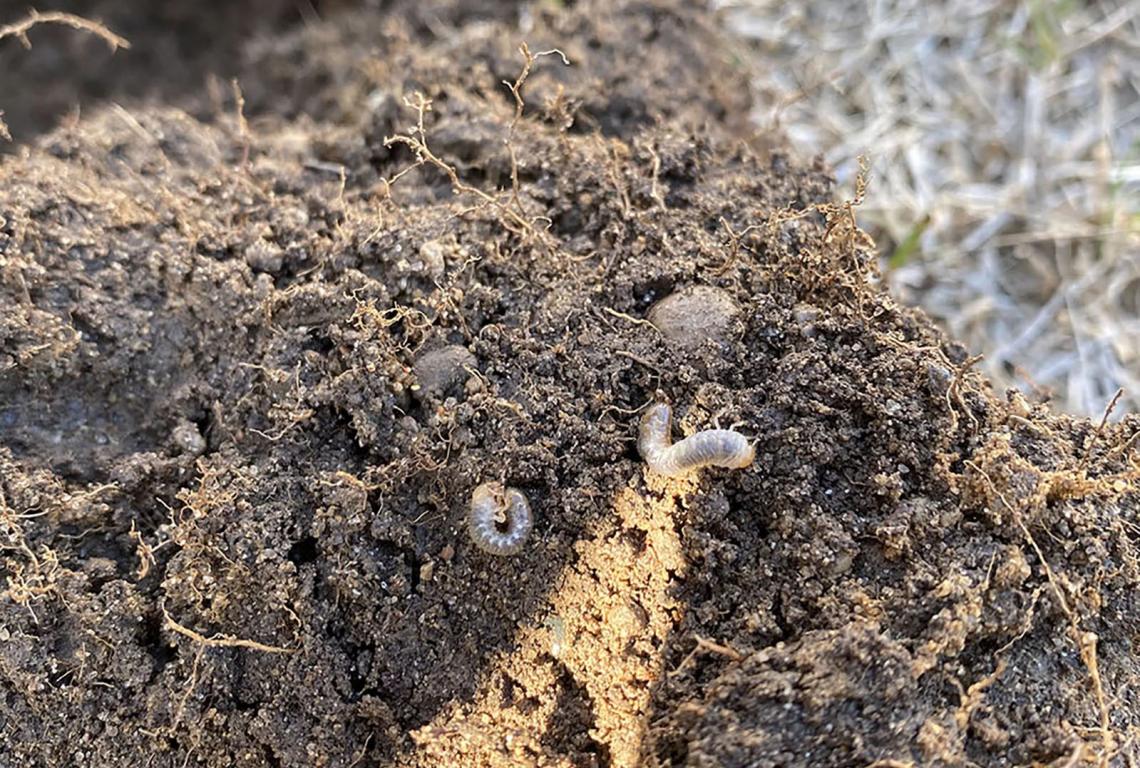Lawn Grub Control Services for Your Home
Understanding Lawn Pride’s Grub Treatment Services
Beetles plant eggs in grassy lawns. Those eggs grow into larvae and eat the roots of grass, causing brown patches of dead grass around your yard. This type of underground pest infestation can plague the proudest homeowners who do everything right when caring for their grass. The best way to fight grub infestation is with the help of trained lawn care professionals. Lawn Pride offers grub control programs that prevent grubs in your lawn from being a serious problem. Learn more about our grub control services.
Signs That You Have a Grub Infestation
Many homeowners have a grub problem and don’t even know it. You can only solve a problem after you have identified it. Grubs live below the ground for most of the year. So, above ground, grub infestations can just look like unhealthy grass. There are a few common signs of grub infestations. If you notice any of the following signs, you need lawn grub control services to stop your grub problem from getting out of hand. Some of the most common signs of grubs include the following:
- Dead Grass – Your lawn’s grub damage may take many forms, but dead grass is the most common. Grubs primarily eat roots and other underground organic material. As a result, they will cut off the main source of nutrients and water for your grass, causing it to die.
- Beetles – Grubs are just larval forms of beetles, like June bugs, masked chafer beetles, and even Japanese Beetles. Some of these beetles, like Japanese beetles, are invasive species with no natural predators to keep their populations under control. Beetles usually come out of the ground between May and July, making themselves visible. However, that can vary depending on your location and weather conditions.
- Rolling Dead Grass – This is the most reliable way to find grubs. If you suspect a section of your lawn has grubs, try to lift that section of grass. With extensive grub infestations, you will easily be able to roll that section of grass like a rolled-up carpet. When you do this, you will likely be able to spot a few grubs in the soil.

Preventative Treatments vs. Curative Treatments
Grub treatments come in two main forms: preventative and curative. Preventative grub control treatments aim to kill larvae before they hatch or become active enough to damage your lawn. On the other hand, curative treatments are the solution for active grub infestations. This will destroy grubs that have grown larger and started to eat your grass at a rapid rate. In reality, most homeowners with a grub problem are best served with a program that combines these two treatments at different times of the year to correspond to the lifecycle of the grubs.

Frequently Asked Questions About Grub Control
Grub control can be slightly confusing at first unless you are a professionally trained lawn care specialist. While our team is always happy to answer your questions and inspect your yard for grubs, we have provided the answers to a few of the most commonly asked questions about grubs.
What Are Grubs?
Grubs are the larval stage of beetles. Beetles lay eggs under the soil. Those eggs grow into larvae. The larvae eventually form a pupa, and an adult beetle hatches out of that pupa. While they are grubs, they start as very small worms and grow into inch-long pests that look like worms. Grubs almost always grow in large clusters. So, if you find one grub in your lawn, there are almost certainly more.
Will Winter Kill Off All the Grubs in My Lawn?
Not really. While cold weather can kill some grubs, it is not an effective treatment for an infestation. As temperatures plummet, grubs dig deeper and deeper underground, insulating them from themselves coldest weather. When spring comes around, the grubs will climb closer to the surface, eat your grass from the roots, and repeat their lifecycle.
When Is the Best Time of Year to Get Grub Control Services?
The best grub control schedule for your lawn will depend on your location and local weather conditions. Generally speaking, preventative grub control treatments are most successful when the grubs are ready to hatch and start feeding, which occurs sometime between May and July. Curative treatments work best when the grubs are entering their mature stages of life, in the mid-to-late summer. Our grub control experts will happily work with you to develop an effective grub control schedule for your lawn.

Request a Free Grub Control Estimate Today!
Lawn Pride is more than just a lawn care company. We are a grub control company as well. While we are equipped to provide all the expertise you need to keep your lawn green and healthy, we also specialize in grub control programs. Even better, we offer free estimates for our services. To begin making your lawn as healthy as possible, request a free grub control estimate today!




